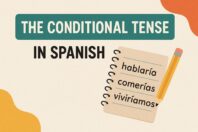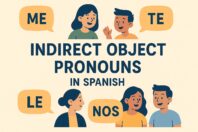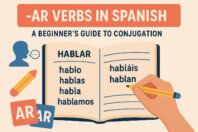Spanish Greetings & Goodbyes: The Ultimate Guide

Get our free email course, Shortcut to Conversational.
Have conversations faster, understand people when they speak fast, and other tested tips to learn faster.
More infoLearning the most common phrases for greetings and goodbyes in Spanish is an important part of Conversation 101.
Of course, you probably already know the most basic Spanish greeting: ¡hola!
But there are a million different ways to say “hi” in Spanish, just like in English. And each one is used in slightly different situations. By using this guide to Spanish greetings, you’ll not only just know the words, but when to use them, and when not to. You’ll also know how to say goodbye in Spanish, which is much simpler. We’ve stacked this guide with a handful of example situations to make sure you “get it”.
Mafalda takes you through some additional greetings in the video below, while after the sections on Spanish greetings and goodbyes, Melissa reviews the ones we introduce here. Plus, at the end of the post, we have a slang section where we cover how to say “what’s up” in the local slang for nineteen Spanish-speaking countries.
Greetings in Spanish: Basic Phrases
There are many ways to greet someone in Spanish, but 99% of the time, you’ll use one of the eight below.
| Spanish | English |
|---|---|
| hola | hello |
| ¿qué tal? | what’s up? |
| buenos días | good morning |
| buenas tardes | good afternoon |
| buenas noches | good evening |
| buenas | (abbreviation for all buenas greetings) |
| ¿cómo estás? | how are you? |
| ¿cómo vas? | how’s it going? |
¿Qué tal?
This is an informal greeting and you can use it with your friends and family whenever. It’s sort of a universal “what’s up?”.
Buenos días
This is a very formal way to greet somebody you don’t know or somebody you respect a lot. Use it in the morning.
Buenas tardes
If you walk into a business meeting at 2:00 pm you should totally use this greeting. This is the afternoon formal greeting (It would be very weird to say good afternoon to a friend, wouldn’t it?)
Buenas noches
Like buenos días and buenas tardes, this is a formal greeting. You use this at night. It’s sort of the equivalent to “good evening” in English – this is just used as a greeting though. To say “good night” (e.g. when going to sleep), you would typically use “descansa” (this basically means, “rest”, from the verb descansar).
Buenas
Do you usually say “morning” instead of “good morning”? If you do you’ll use this greeting a lot. It has the same context and you can use it at any time of the day.
¿Cómo estás?
This is an informal way to ask somebody how they are or how they feel. If you want to be more formal you can drop the S and go with “¿Cómo está?”
¿Cómo vas?
This is another informal way to say “how are you”. It’s also similar to “¿Qué tal?”
OK, let’s cover some example situations, what you would use in each case, and why.
Situation: In a Cafe
Imagine you are in a cafe and you walk in, and recognize an old friend of yours sitting in the corner. You walk over, and say… ¿qué tal?
Explanation: Because you are already friends, using “buenas” is way too formal. You could also say “hola”, but that’s too plain – between friends you are more likely to use something like “whats up? I haven’t seen you in awhile!” in this situation. Thus, we use “¿que tal?”.
Depending on what country you are in, the local slang version of this will be different. Jump to the slang section of this post to check what it is for where you are, or where you’re headed.
Situation: Meeting your In-laws
Imagine you are about to have dinner with your in-laws for the first time (scary, right?). You shake hands and say… “Buenas noches” or “Buenas noches, ¿Cómo están?”. When the night is over you should end it with “Que tengan buena noche”, “Feliz noche” or if you plan to see them again the next day “Hasta mañana” could work as well.
Explanation: Because you are meeting them for the first time and you want to make a good first impression you should use the most formal stuff. When you see them next time you can use “Buenas” and that’ll be totally fine. Unless you have a close friend relationship, avoid going less formal than “buenas”.
Situation: Texting somebody
You are about to start a text conversation with a friend or even with that person you like. You can say: “¿Cómo vas?” (How is it going?), “¿Cómo estás?” (how are you?) or “¿Qué tal?” (what’s up?).
Explanation: These are informal and friendly expressions to greet somebody. You can also follow the conversation with the question, How is your day going? “¿Cómo va tu día?”.

Unsure what to learn next?
Download the exact curriculum that thousands of BaseLang students have used to become fluent in Spanish.
Download Guide Now!
Goodbyes in Spanish: Basic Phrases
While there are many ways to say hello (as you’ll see in the slang section soon), goodbye is pretty simple: “hasta luego”, “chao”, “adios”, “hasta mañana”, and that’s pretty much it.
|
Spanish
|
English |
|---|---|
| hasta luego | see you later |
| hasta pronto | see you soon (less used than hasta luego) |
| hasta mañana | see you tomorrow |
| adiós | goodbye (more permanent) |
| chao | see you later (informal) |
| nos vemos | we’ll see each other (soon) |
Hasta luego
This is formal. You use it when you want to say goodbye to somebody you may see soon (or not), but you’re not sure when.
Hasta pronto
This is semi-formal. If there are chances to see this person again within a couple of days you can use it. Otherwise it’s better to use “hasta luego” or even “adiós”.
Hasta mañana
“Hasta mañana” can be both formal and informal. You can use it if you are totally sure that you’ll see this person the next day. You can also change the time expression for “hasta la próxima semana” which means “see you next week”. Basically you can use the word “hasta” with any time expression like month (hasta el próximo mes), año (hasta el próximo año) or even a day (hasta el lunes).
Adiós
Adiós is informal. We use it mostly as a permanent statement, which means that you don’t expect to see this person soon or ever again. It’s what you could expect to hear from a boyfriend or girlfriend if you break up.
Chao
This is technically Italian, but it’s widely used as a very informal goodbye. It’s used similarly to “peace” in English. Used between friends.
Nos vemos
This literally means “we see each other”, but it’s more used when talking about the future. This is typically used if you know when you’ll see the person, and generally that’s fairly soon.
OK, time for some examples:
Situation: Talking on the phone
If you are on the phone with a friend and you are about to hang up the most common expression you can use is “chao”, but if it’s a more formal conversation, you better use “hasta luego”.
Explanation: Chao is extremely informal and you want to use it only with close friends.
Situation: At the airport
You or somebody important to you is leaving for a couple of months or even years. This is a good time to use “adiós”.
Explanation: Even though that person is not leaving forever it’s going to take a while for him/her to be back, it’s sort of a long-term goodbye.
Situation: Leaving the office
Your work day is over and you are about to go home. Before you do that you should say “See you tomorrow” to your coworkers: “hasta mañana” or “nos vemos mañana”. And if it’s a friday you can say “See you Monday”: “hasta el lunes” or “nos vemos el lunes”.
Explanation: These expressions are formal and informal which means you could use them with your friends, your boss, or even with somebody you just met.
Spanish Slang: Greetings in 19 Countries
You walk down the street and into the bar where you are meeting a close friend. He greets you with…
1. “brooooo, what’s up?”
2. “hello, how are you?”
Which sounds better? More normal, natural?
By using the local slang, even just the local form of “what’s up?” (listed for nineteen Spanish-speaking countries below), makes a huge difference.
Connor told me a story recently that illustrates this well:
“I go to the farmers market every Sunday, and get the same thing from the same guy each week – just some veg. When I first got to Medellín, I didn’t know better, and just gave him a standard “buenas”. But after a few weeks, I started using “qué más parce” (what’s up bro), and now the exact same thing went from costing me 20,000 pesos to 9,000. It’s crazy how big a difference it makes. And that’s just for transactional stuff. When meeting people for the first time, you greet them in the local slang, it just makes them feel more comfortable right away.”
So, here’s how to say “what’s up” in the local slang for nineteen Spanish-speaking countries. This isn’t something we scraped from the internet – we talked to a bunch of real people in each country and asked them how it is.
Colombian Slang
- ¿Qué más?
- ¿Entonces qué?
- ¿Bien o no?
- ¿Bien o qué?
If you are in Medellín, you can say “¿qué més pues?”, as Paisas (people from Medellin) use “pues” (which technically means “well”) almost like an “uhhhm” (that is to say, a LOT).
Venezuelan Slang
- ¡Épale!, ¿qué más?
Spanish Slang
- ¿Qué tal?
- ¿Qué hay?
Chilean Slang
- Hulax
- Ke talka
- Holanda
Mexican Slang
- ¿Qué onda?
- ¡Quiubole!
- ¿Qué más?
Argentinian Slang
- ¿Qué hacés boludo?
- ¿Cómo andás?
Bolivian Slang
- ¿Qué onda?
- ¿Cómo es?
Costa Rican Slang
- ¿Cuál es la última?
- Diay
Cuban Slang
- ¿Qué bola?
Dominican Republican Slang
- ¿Qué lo que?
Ecuadorian Slang
- ¿Qué fue cabrón?
El Salvadorian Slang
- ¿Quiondas macizo?
- ¿Quionda vos?
Guatemalan Slang
- ¿Qué onda vos?
Honduran Slang
- ¿Qué pedos?
- Kiubole
Nicaraguan Slang
- ¿Qué honda, chele?
Panamanian Slang
- ¿Qué xopa?
- ¿Qué e’ lo que e’?
Paraguayan Slang
- ¿Qué tal?
Peruvian Slang
- ¡Habla!
- ¿Qué más?
Uruguayan Slang
- ¿Qué haces gil, todo bien?
- ¿Qué haces guacho?
OK, that about covers it. This is pretty much all you’ll ever need when it comes to Spanish greetings and goodbyes.



